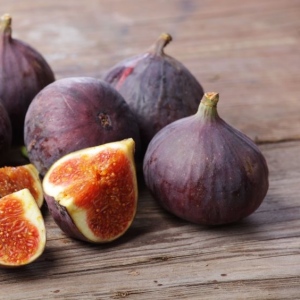With delicate skin, intense sweetness and a fleeting shelf life, fresh figs are a rare delicacy that is well worth a try should you find them at your local market. They are in season end of June through early Fall.
Historically, figs are one of our oldest fruit crops, originating in Southwestern Asia prior to the agriculture of wheat and legumes. Today figs are cultivated in California, along with Greece, Portugal, Spain and of course, Turkey.
The figs pictured in the image above are Brown Turkey Figs; also popular are the Black Mission Figs with pink flesh and the Calimyrna with greenish skin and amber colored flesh.
The many health benefits of fresh figs include:
- Are an excellent source of manganese, which protects the mitochondria, our source of energy.
- Are high in fiber, promoting healthy elimination.
- Lubricating to the large intestine, which has a mild laxative effect .
- Aid digestion by soothing the intestines.
- Support blood sugar balance, for more consistent energy.
Figs are a well known natural remedy for constipation. Try soaking dried figs overnight and drinking the water in the morning.
Buying, storing and preparing figs:
When fresh, figs are best eaten ripe. Once they’re picked they don’t get any sweeter, but they quickly soften and ripen. They’re best eaten within one to two days of being purchased.
If they are ripe when purchased, store them covered in the refrigerator on a paper towel. If the figs are not yet ripe, keep them at room temperature. Dried figs will last much longer, and can be stored in the refrigerator in an airtight container.
Select soft, plump figs with the skin intact. Rinse prior to eating, and enjoy with or without the skin.
Because the insides are soft, chopping a fig can be difficult. Place your fresh fig in the freezer for 1/2 hour, then chop.
Quick serving ideas:
- Puree and use as a sandwich spread with chicken or veggies
- Perfect as an appetizer with fresh basil and balsamic vinegar
- Can be quartered and added to green salad or fruit salad
- Cut into quarters and serve with a drizzle of honey
- Can be baked into bars or breads
- Make into a jam and serve with fresh, raw cheese
- Figs are great as a breakfast. Light eaters, try the Fresh Figs & Yogurt Breakfast or for a more hearty breakfast, enjoy my Overnight Autumn Oats.
This week’s Simple Action Step:
Check your local market for fresh figs this week. If you’re lucky enough to find them, try the breakfast yogurt! And, let me know what you think.




